The prehistoric world awed many travelers long before Jurassic Park hit theaters. Although we might never have the chance to view these extinct animals in the flesh, there are plenty of fossils for amateur paleontologists and dinosaur fans to study. The United States is home to a truly stunning variety of these sites, ranging from active dig sites littered with prehistoric rhinos to a highly concentrated pile of Allosaurus skeletons that have confounded paleontologists for decades.
Cleveland – Lloyd Dinosaur Quarry, Utah
Musuem at the Cleveland – Lloyd Dinosaur Quarry. Image credit: Bureau of Land Management/Flickr.
About 30 miles south of Price, Utah, in the heart of Dinosaur Country, is where you’ll find this dinosaur quarry. It is situated near the northern edge of the San Rafael Swell. The University of Utah found the location in 1929 and excavated it for three years. Jurassic National Monument’s Cleveland-Lloyd Dinosaur Quarry is situated at an elevation of 5800 feet. One of the most spectacular collections of dinosaur fossils and bones from the Jurassic Morrison Formation may be found at this location. Here, more than 12,000 bones have been discovered, representing at least 70 distinct prehistoric animals. These bones have been put back together and are now on exhibit in museums all across the world. The deposit contains the highest concentration of Jurassic dinosaur bones ever discovered, which is more important.
Dinosaur National Monument, Colorado-Utah Border
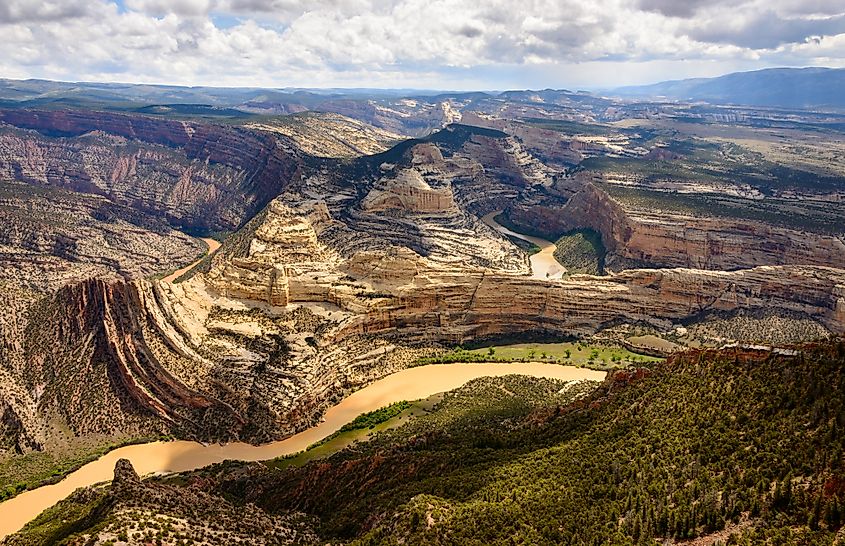 Aerial view of the Dinosaur National Monument.
Aerial view of the Dinosaur National Monument.
Dinosaur National Monument is a sizable area of protected territory located near the northern state border of Colorado and Utah. From the outside, it appears to be a desolate wasteland of bare desert. But after you delve much farther, you’ll find one of the richest dinosaur deposits on Earth. There are interactive displays in two different tourist centers, one each in Colorado and Utah. Only at the Quarry Exhibit Hall at the Utah entrance may visitors see dinosaur fossils. Here once lived dinosaurs. They left behind amazing ruins that are still clearly visible in the rocks. Today, a variety of species is supported by the mountains, the desert, and the wild rivers running through deep valleys.
Dinosaur Valley State Park, Texas
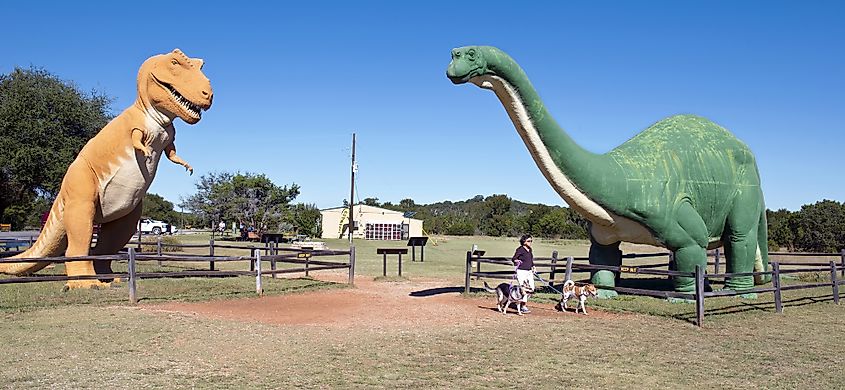 Dinosaur Valley State Park near Glen Rose,Texas.
Dinosaur Valley State Park near Glen Rose,Texas.
Dinosaur Valley State Park, a scenic 1524.72-acre park in the Paluxy River in Somervell County, is located roughly northwest of Glen Rose. Visitors to Dinosaur Valley State Park in Texas may be led to believe that thunder lizards previously roamed the area by the enormous dinosaur statues that now dominate the area—and they would be correct. The Cretaceous Ocean shoreline marked by the Paluxy River that flows through the park is where dinosaurs once trod, leaving deep tracks in the mud. Thousands of years later, the footprints have become amazingly distinct fossilized stone features.
Nash Dinosaur Track Site and Rock Shop, Massachusetts
The first dinosaur footprints discovered in North America were in this valley. When compared to other locations, the Nash Dinosaur Track Site and Rock Shop have created the most dinosaur footprints. The longest-running dinosaur footprint quarry in the world, Nash Dinosaur Tracks, has been in operation there since 1939. Since then, it has created countless dino tracks that have been sold to museums and private customers worldwide. The Nash Dinosaur Track Site and Rock Shop are about a mile from the earliest dinosaur footprints in the Connecticut River Valley, which were found in 1802. It used to be known as “Dinosaurland.” There are also sales of many of the fossils displayed.
Petrified Forest National Park, Arizona
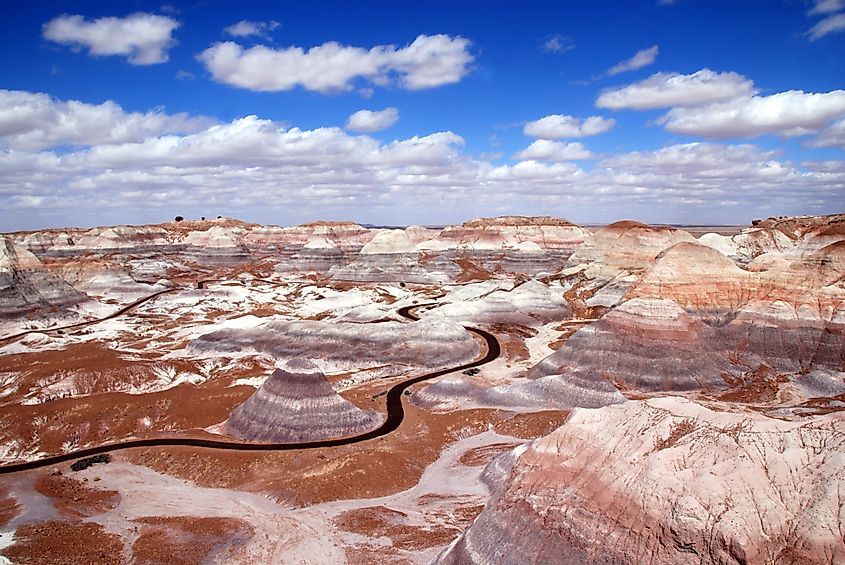 The landscape of the Petrified Forest National Park, a place rich in dinosaur fossils.
The landscape of the Petrified Forest National Park, a place rich in dinosaur fossils.
The fossil fauna of Petrified Forest National Park includes dinosaurs, which are uncommon yet significant. The Late Triassic “dawn of the dinosaurs,” when these species first came on Earth, is preserved in park deposits. The Triassic dinosaurs of Arizona were mostly tiny, bipedal carnivores no larger than humans in size, as opposed to the enormous sauropods, horned dinosaurs, and the fabled Tyrannosaurus rex of the later Jurassic and Cretaceous periods. The majority of park visitors are shocked to learn that dinosaur fossils are an uncommon find there. Instead of a lack of dinosaurs in the Triassic, this rarity is probably the result of characteristics of fossil preservation.
Dinosaur Ridge, Colorado
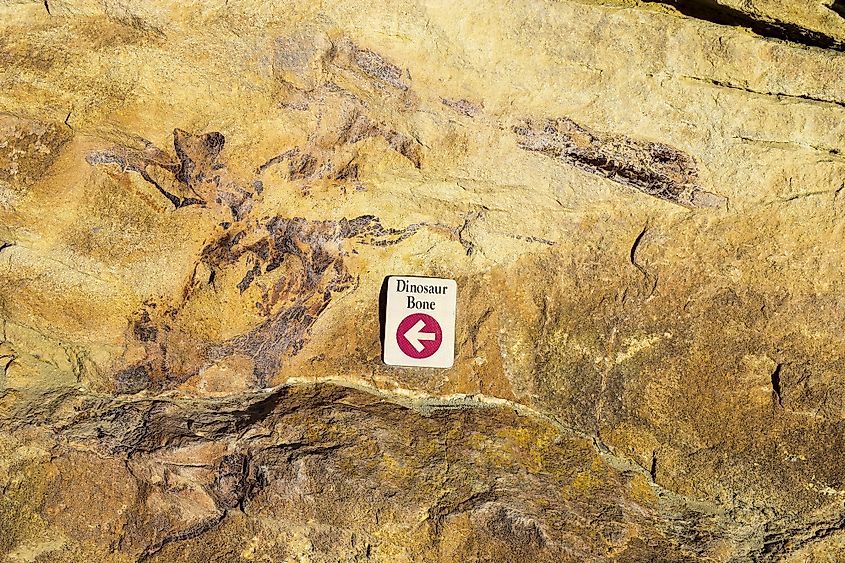 Dinosaur impressions on rocks at Dinosaur Ridge.
Dinosaur impressions on rocks at Dinosaur Ridge.
The Cretaceous and Jurassic Period fossils found at Dinosaur Ridge, an outdoor and indoor museum close to Morrison, were originally identified and analyzed during the Bone Wars of 1877. A National Natural Landmark called Dinosaur Ridge can be found to the east of Red Rocks Park and Amphitheatre. Paleontologists regard it as one of the top dinosaur track sites worldwide and the number one site in the United States.
Two Medicine Dinosaur Center, Montana
According to the Guinness Book of World Records, the Seismosaurus skeletal model displayed at Montana’s Two Medicine Dinosaur Center is the world’s longest dinosaur. This 137-foot model, which has a curving neck and tail and a natural-looking shape, was created by paleontologist Dave Trexler of Two Medicine. Several exhibits include the real remains of other new dinosaur species as well as the first baby dinosaur remains discovered in North America, which were recently highlighted on CNN. The Two Medicine Dinosaur Center of Montana offers programs that are meant to let participants work alongside real researchers and personnel. Participants can acquire the most recent ideas and methods of fossil preservation through such contact, which improves the reporting and recording of fossil findings.
Dinosaur State Park, Connecticut
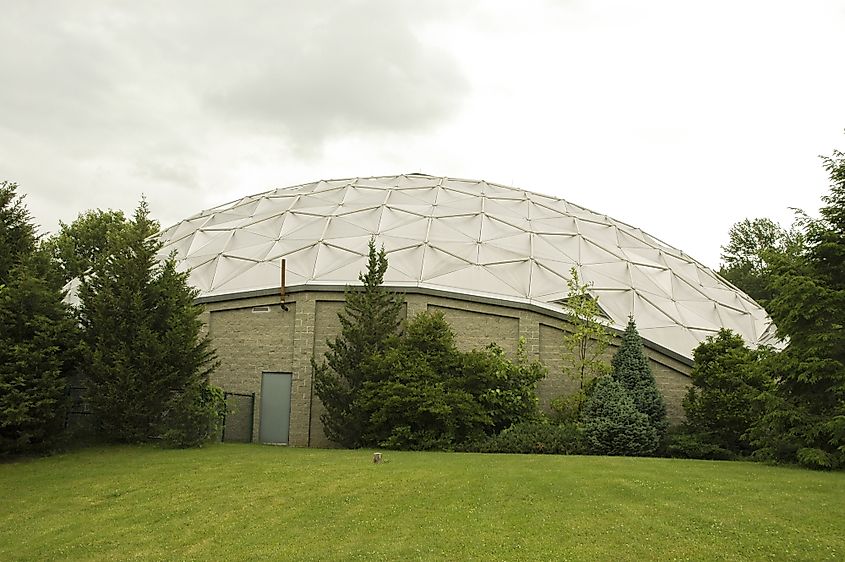 Dinosaur State Park in Connecticut.
Dinosaur State Park in Connecticut.
Fossil track finds have a lengthy history in the Connecticut Valley. Outstanding artifacts discovered in brownstone quarries during the 19th century made their way into museums all over the world. More than 2,600 different dinosaur footprints can be seen at the location. Most of them fall under the Eubrontes Giganteus category. The first idea was to construct a sizable exhibit center above the primary trackway after the discovery. Budgetary restrictions prevented the building, nevertheless. They were reburied in 1976 and still are now to protect the main trackway.
Despite becoming extinct millions of years ago, dinosaurs remain popular. Adults and children alike are still drawn to fossil sites and exhibits by the thought of the planet’s once-dominant flesh-eating beasts. They are significant because they provide a concrete link to the lifestyles, environments, and climates of the past. They demonstrate how life, the environment, and the climate have evolved over time, as well as how living things have reacted to those changes.
Jana Zakaria June 30 2022 in Places
Unlock the world’s wonders with unforgettable journeys tailored just for you! Whether you crave sun-kissed beaches, thrilling adventures, or rich cultural escapes, your dream destination awaits. Enjoy seamless travel with expert tips, exclusive deals, and handpicked experiences that Turn Every Trip into a lifetime memory.










